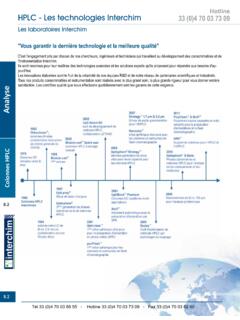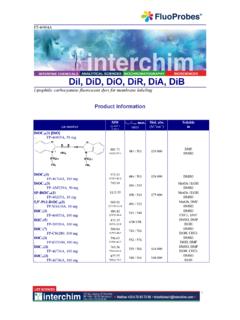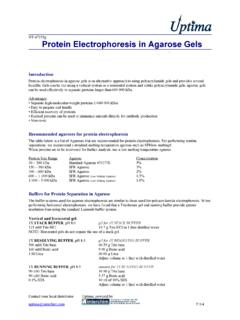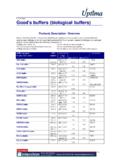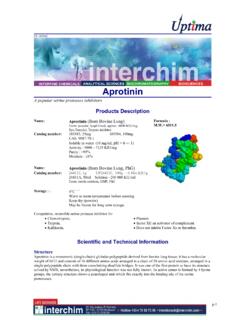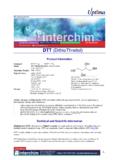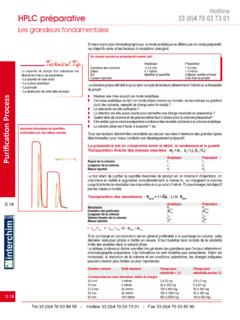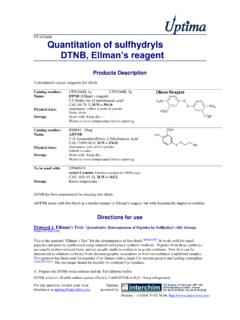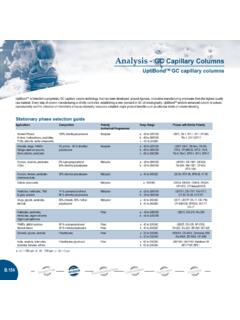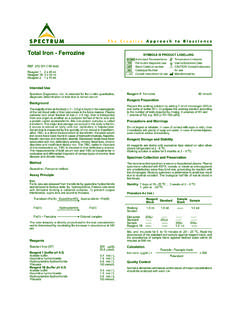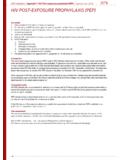Transcription of OPA, amine detection reagent - interchim.fr
1 FT-02727 AOPA, amine detection reagentSensitive fluorescent detection reagent for amines ( aa, proteins and peptides)Works also by absorbance; Can also be used for thiols DescriptionPart number:02727A1gChemical Name:o-Phtalaldehyde (OPA)CAS 643-79-8, excitation = 340nm, emission = 455nmStorage :+4 C for long term (possible at room Temperature), protected from light and moisture (H)OPA reagent provides a very high sensitivity detection reagent of amines, notably contained in proteins,peptides, and aminoacids. It can also be used to quantitate offers a highly purified OPA for best results in HPLC, capillary electrophoresis, and spectrophotometric assays of protein/peptide and & technical Information OPA is well soluble, and stable in water solution at pH< It is however sensitive to UV illumination andair oxidation.
2 In adequate conditions, OPA reacts in presence of thiols specifically with primary amines above theirisoelectric point Pi. The reaction during 1 minute (less for glycine). The reaction starts within 15 seconds and can be monitored by absorbance, and by fluorescence. The formedderivates are however not at 340nm increase within 15seconds up to 1-3 minutes, then decreases more or less slowly. maximum absorbance is maintained between 1 and 1 30. One mole of NH2 gives onOD340nm of approximately 10 units. Acetone and Dioxane don t affect the more sensitive detection is achieved by fluorescence, with excitation at 330-390nm ( ), andmeasurement at 436-475nm (max 455nm).
3 There are noticeable variations of the fluorescent signal betweenamino-acids, and fluorescence might increase with pH values (not for histidine). Thus it is recommendedfor accurate and sensitive results to use a purified standard homologous of the molecule of interest, toeventually optimize reaction duration and pH (between 9 and ). OPA reacts also with thiols in presence of an amine such as n-propylamine or for use: Protocol for proteins and peptidesProtocol for Amino-Acids / amines Guideline for Thiols Directions for useProtein and peptide assay | Amino-Acids detection / amines | Amino-Acids detection / thiols Here are 2 standard protocols.
4 Conditions should be optimized for specific applications, notably the duration of incubation depending on amino acid or aa-content of 1 : Protein and peptide assayThis protocol is designed to measure amine content in peptides and proteins to control the degree of labeling or conjugation (differential amine content before and after labeling). -acetytl-lysine can be used as standard, containing 1 amine per molecule. A ratio of labeling can then be a 50mM carbonate buffer2-Prepare the working reagent :5mg of OPA + 100 l of pure Ethanol + 5 l of b-2-mercatoethanol + 10ml of 50mM carbonate buffer OPA reagent should be protected from direct light, and used within 2 hours.
5 It can eventually be stored under nitrogen in ambered glass vials for 1-2 weeks at 4 the standards:Prepare a 10mM acetylLysine (09111A) standard solution in water ( acLys + 1ml dH2O)Prepare serial dilutions of 800 to 12 M of acLys standard solution in carbonate : for accurate quantitation, a standard curve may be prepared with a purified peptide or protein4-Prepare samples dilutions in carbonate :Pipette 100 l of sample in clean disposable : plastic tubes of bad quality may produce background signal. Check that OD of a blank is quite stable within 0+5min6-Add 1ml of OPA reagent (1-), incubate at room temperature for 2min:7-Place the solution in spectrophotometer, and read absorbance at 340nm at exactly 2minRem : readings should be performed after the same incubation duration for greater accuracy.
6 ODs are sufficiently stable between 1min and 2minutes for acLys and 2-4min for proteins. The incubation period may so be optimized, down 1min30 and up 10min, depending of proteins and standard (same known protein is better).Rem : the solution should be put in the spectrophotometer just before reading, because continuous exposure to UV affects the : One sample can be prepared during the incubation of the previous : The duration of incubation could be sat up with the molecule of a standard curve of amine detection , with the molar concentration of standard in x-axis and ODs on y-axis, then calculate for each sample the corresponding amine concentration.
7 Calculate the sample concentration taking in account the dilution sensitivity of 10 M can be obtained with absorbance measurement. For higher sensitivity, the concentration of OPA can be protocol could be adapted to microplates. Use transparent plates for working in absorbance (or opaque black plates for working in fluorescence). The OPA reagent distribution in wells and OD reading should be well timed, use 100 l of sample, read at 340nm (blank), add 100 l of OPA reagent , and read again at 340nm. This protocol can be adapted to fluorescent measurement with a fluorimeter. A wide dynamic range of detection can be achieved (15-1000 g/ml of protein), or very sensitive but shorter range (1-50 g/ml) by increasing up 20 fold the OPA/protein ratio.
8 2 : Amino-Acids / amines detection1-prepare a fresh solution of 70mg OPA + 1ml Methanol + 95ml of buffer (25g/L of Boric acid (UP07044), Brij 35 (UP09187), 2-mercaptoethanol). Purge with N2 and store in the dark (stable for 1-2 weeks).2-Pre-column derivatization is recommended for optimum sensitivity. Inject the OPA reagent with the sample before the chromatographic separation (2-fold volume excess). Agitate for 1 minute, and inject onto column. For post column derivatization, use flow rate of OPA reagent equal to eluant).A sensitivity of low picomole range can be obtained. See references line for use 3: Thiols detection Thiol reaction with OPA require the presence of an amine , such as n-propylamine or 2-aminoethanol.
9 See references informationReferences forPeptide and protein spectrometric or fluorometric assayBertrand-Harb C., Nicolas , Dalgalarraondo M., Chobert , Determlination of alkylation degree by three colorimetricmethods and amino-acid analysis? Acomparative study, Science des aliments 1993, 13, 577-584 Jones, and Gilligan, (1983). American Biotechnology Laboratory, December Issue, K. et al.; J. Chem. Soc., Perkin Trans. II, 12, 2089-2092 (1990). The intramolecular Cannizzaro reaction of o-phthalaldehyde Vanden Eynde et al. ; Bull. Soc. Chim. Belg. 101, 6, 529-12(1992): Novel syntheses of heterocycles with N-(1-haloalkyl)azinium halidesReferences forChromatography applicationsGardner W.
10 , Miller W., 1980, Reverse-phase liquid chromatography analysis of amino acids after reaction with o-phtalaldehyde. Analytical Biochemistry, 1980, 101, 61-65 Ogden G. and Foldi P., Amino acid analysis: an overview of current methods. LC-GC 1987, 5(1), 28-38 Roth M., Fluorescence reaction for amino acids, , 1971, 43, 880-882 Lindroth, P. and Mopper, K. (1979). Anal. Chem. 51, , and Drescher, (1979). J. Biol. Chem. 254, Eijk, , et al. (1988). Clin. Chem. 34, , , et al. (1985). Anal. Biochem. 151, , H., et al. (1984). J. Chrom. 297, , (1986). J. Chrom. 359, , , et al. (1984). Anal.
